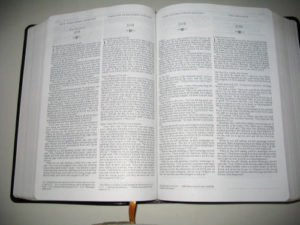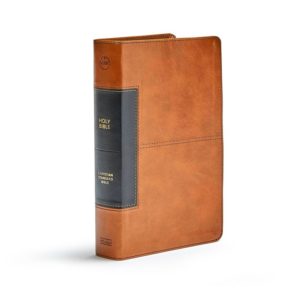Aug
16
I don’t use parallel Bibles.

In case you aren’t familiar with the term, a “side-by-side” or parallel Bible is one that has two or three or four (or, in rare cases, more) translations presented in parallel columns. Usually, at least one uses the formal/essentially-literal approach to translation and at least one uses functional/dynamic equivalence. This format allows for immediate comparison of grammatical structure, word choices, etc., together in one volume. It’s a great concept — assuming the font size is big enough not to cause eyestrain. (For me, that is 8pt. or above.) A clean layout and typeface are desirable, too, of course.
The problem, though, is that I can’t find a combination that I want. They all seem to include one or more of the following, which I don’t generally care for: King James Version (KJV), Amplified (AMP), The Message (MSG). I have discussed some of my reservations re the KJV in an earlier post. The Amplified, put out by the same Lockman Foundation that produces the NASB, is a fine formal translation. My concerns with it are a) I find it a little awkward to read, and b) I am concerned that some (many?) who use it think that, just because a particular word/phrase is given multiple “synonyms” or alternates, they are all equally applicable in a particular verse. Not so! As for the MSG paraphrase, please check out this guest post.
On the other hand, there are several translations — ranging from formal to dynamic in approach — that rarely if ever appear in parallel Bibles, but which I would love to see in such a format. I have come up with a few combinations that would definitely appeal to me, and I will share them here, using the Lord’s Prayer (aka “Our Father”) from Matt. 6:9-13 as a sample passage. The first includes some widely-known and popular translations, whereas the others get increasingly eclectic or specialized. (Note: I have limited this assessment to English-language translations, since that is the only language I’m fluent in.)

NASB/NKJV/NIV/NLT: The New American Standard Bible (preferably the 1995 update (NASU or NASB95)) provides a strong formal translation for our base. The New King James Version is, believe it or not, a little less formal. It has the advantage of being in the KJV tradition but without the old-timey words & phrases. Then we have the popular New International Version, a “mediating” translation — i.e., not too formal, yet not too dynamic. Finally, the New Living Translation gives a well-done text solidly in the “dynamic equivalence” area of the spectrum.
NASB –
9 “Pray, then, in this way: ‘Our Father who is in heaven, Hallowed be Your name.
10 ‘Your kingdom come. Your will be done, On earth as it is in heaven.
11 ‘Give us this day our daily bread.
12 ‘And forgive us our debts, as we also have forgiven our debtors.
13 ‘And do not lead us into temptation, but deliver us from evil. [For Yours is the kingdom and the power and the glory forever. Amen.’]
NKJV –
9 In this manner, therefore, pray: Our Father in heaven, Hallowed be Your name.
10 Your kingdom come. Your will be done On earth as it is in heaven.
11 Give us this day our daily bread.
12 And forgive us our debts, As we forgive our debtors.
13 And do not lead us into temptation, But deliver us from the evil one. For Yours is the kingdom and the power and the glory forever. Amen.
NIV –
9 “This, then, is how you should pray: “‘Our Father in heaven, hallowed be your name,
10 your kingdom come, your will be done, on earth as it is in heaven.
11 Give us today our daily bread.
12 And forgive us our debts, as we also have forgiven our debtors.
13 And lead us not into temptation, but deliver us from the evil one.’
NLT –
9 Pray like this: Our Father in heaven, may your name be kept holy.
10 May your Kingdom come soon. May your will be done on earth, as it is in heaven.
11 Give us today the food we need,
12 and forgive us our sins, as we have forgiven those who sin against us.
13 And don’t let us yield to temptation, but rescue us from the evil one.

ESV/CSB/NET/CEB: Based on the RSV, the English Standard Version is a very popular formal translation these days, and I actually prefer it just a bit more than the NASB95. Translators for the Christian Standard Bible (like its predecessor, the Holman’s Christian Standard Bible) used an “optimal equivalence” approach that retains much of the more formal language but recognizes the need to occasionally go a bit more dynamic in order to avoid obscuring the meaning for a modern audience. (My preference would actually be the HCSB, but since it has been discontinued in favor of the CSB, the latter makes more sense.) The New English Translation is a “mediating” translation similar to the NIV but with some interesting differences. The Common English Bible is a dynamic translation that is known to be less conservative and more ecumenical in some of its choices, including a few odd words/phrases. (An acceptable alternative for the CEB might be the GNT (see Part 2).)
ESV –
9 Pray then like this: “Our Father in heaven, hallowed be your name.
10 Your kingdom come, your will be done, on earth as it is in heaven.
11 Give us this day our daily bread,
12 and forgive us our debts, as we also have forgiven our debtors.
13 And lead us not into temptation, but deliver us from evil.
CSB –
9 “Therefore, you should pray like this: Our Father in heaven, your name be honored as holy.
10 Your kingdom come. Your will be done on earth as it is in heaven.
11 Give us today our daily bread.
12 And forgive us our debts, as we also have forgiven our debtors.
13 And do not bring us into temptation, but deliver us from the evil one.
NET –
9 So pray this way: Our Father in heaven, may your name be honored,
10 may your kingdom come, may your will be done on earth as it is in heaven.
11 Give us today our daily bread,
12 and forgive us our debts, as we ourselves have forgiven our debtors.
13 And do not lead us into temptation, but deliver us from the evil one.
CEB –
9 Pray like this: Our Father who is in heaven, uphold the holiness of your name.
10 Bring in your kingdom so that your will is done on earth as it’s done in heaven.
11 Give us the bread we need for today.
12 Forgive us for the ways we have wronged you, just as we also forgive those who have wronged us.
13 And don’t lead us into temptation, but rescue us from the evil one.
I should probably mention that most of these translations have footnotes (e.g., text critical, translational, or study notes), too. For this particular passage, the NET has the most (9), while the CEB has the fewest (0).
What do you think, so far? Do you like my selections for parallel Bibles? Hopefully the Bible passage I chose is helpful for getting a feel for the differences between some of these translations. (I wanted to put them in a 4-column table, but my blog theme doesn’t have a very wide text area, so I opted against it.) I have more combinations to suggest, but I’ll leave that for Part 2….















